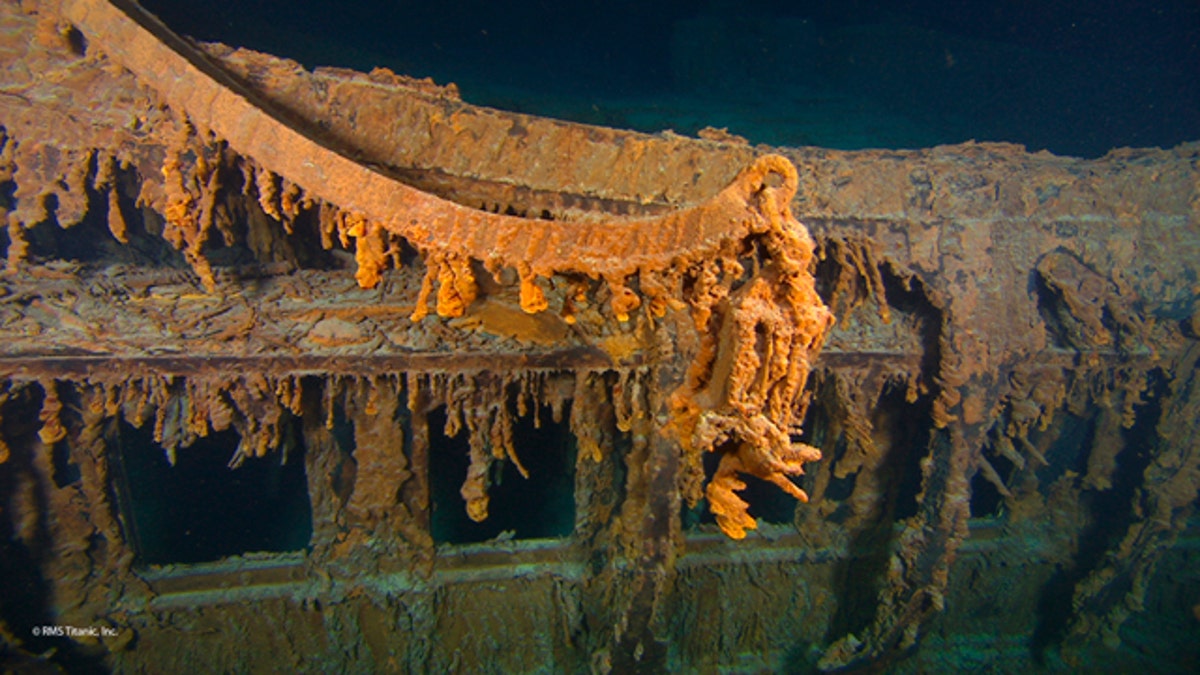
The last "davit" remaining on the wreck of RMS Titanic. These lifeboat cranes were used to hoist the ship's wooden lifeboats over the side and into the water during Titanic's sinking. Many of the boats launched soon after the sinking were not close to fullpassengers refused to believe the seriousness of the situation. (AP Photo/RMS Titanic Inc)
NORFOLK, Virginia – Scientists showed some never-before-seen images of the Titanic in a Virginia courtroom Thursday, unveiling dramatic three-dimensional views of the rusting hulk and the ghostly images of the sea floor where the ship sank almost a century ago.
The Titanic struck ice while making its maiden voyage on April 14, 1912, about 400 miles (645 kilometers) off Newfoundland, Canada. More than 1,500 of the 2,228 passengers and crew perished as the liner plunged into the deep. The images taken from a remote-controlled submersible vehicle were shown to a judge Thursday amid an ongoing salvage claim involving the world's most famous shipwreck.
Scientists who took part in a 2010 expedition to the North Atlantic wreck site said the images are the most extensive and highest quality ever taken of the Titanic. The expedition also fully mapped the 3-by-5-mile(4.8-by-8 kilometer) wreck site, which is located 2 1/2 miles (4 kilometers) below the ocean's surface. The experts said the entire debris field has now been documented for the first time.
The new images will ultimately be assembled for public viewing, scientists said, and to help oceanographers and archaeologists explain the ship's violent descent to the ocean bottom. It is also intended to provide answers on the state of the wreck, which scientists say is showing increasing signs of deterioration.
The findings were presented in a federal courtroom in Norfolk where a salvage claim is still being decided 26 years after the Titanic was discovered by oceanographer Robert Ballard.
The most striking images involved the 3-D tour of the Titanic's stern, which lies 2,000 feet (609 meters) from the bow. Attorneys and court visitors donned 3-D glasses as a camera in a remote-controlled submersible vehicle skimmed over the stern, seemingly transporting viewers through scenes of jagged rusticles sprouting from deck, a length of chain, the captain's bathtub, and wooden elements that scientists had previously believed had disappeared in the harsh, deep ocean environment.
The images were gathered last year using submersibles that were either tethered to a research vessel or programed to skim the ocean floor -- "mowing the lawn," in the words of one scientist.
The scientists said previous sonar and optical images were random and akin to snapshots, while the expedition strived to record and map every inch (centimeter) of the wreck and its resting place using the latest recording technologies. Individual images are stitched together in a mosaic process to create large-scale, almost panoramic views of the wreck.
"We have an image of everything. That's what's important," said William N. Lange of the Woods Hole Oceanographic Institution in Massachusetts. "This has never been done before in the deep sea."
The cameras did not probe the interior of the wreck.
The 2010 expedition, which included many veterans of past Titanic expeditions, was organized by RMS Titanic Inc. The company has exclusive rights to salvage the Titanic, and has gathered nearly 6,000 objects from the once-opulent cruise ship. They are valued in excess of $110 million.
U.S. District Judge Rebecca Beach Smith ruled last year that RMS Titanic is entitled to full compensation for the Titanic trove, but has not determined how it will be paid. The hearing Thursday was intended, in part, to demonstrate the extraordinary costs to RMS Titanic of organizing the risky expeditions and salvage operations. The seas above the wreck are commonly raked by fierce storms, and the wreck site is pitch black and subject to powerful deep-ocean currents.
Chris Davino, president and CEO of Premier Exhibitions, RMS Titanic's parent, estimated the cost of the 2010 expedition at $4 million to $5 million. He said company officials have not decided whether they will launch another salvage expedition.
Scientists said the images collected by the expedition will someday be available to the public to explore the wreck, navigating the ocean depths as a teenager operates a video game with joy sticks.
Some of the individual images were startling in their detail and grandeur. Huge boilers and engines seemed frozen in time as they rose from the ocean bottom.
Since Ballard and an international team discovered the Titanic, most of the expeditions have either been to photograph the wreck or gather thousands of artifacts, like fine china, shoes and ship fittings. "Titanic" director James Cameron also has led teams to the wreck to record the bow and the stern.
RMS Titanic made the last expedition to site in 2004. The company conducts traveling displays of the Titanic artifacts, which the company says have been viewed by tens of millions of people worldwide.




















